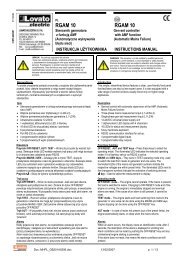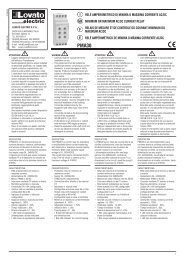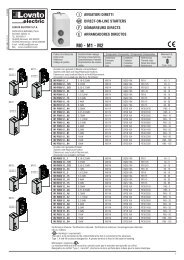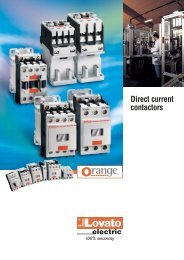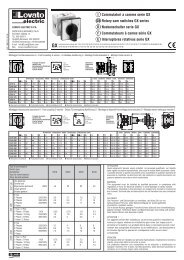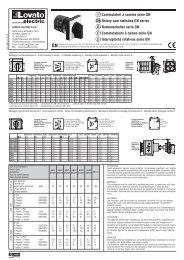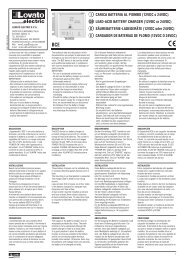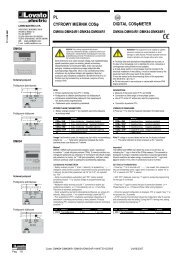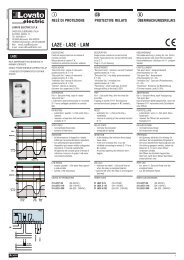Analizatory sieci typu DMG900 I 273 PL GB 0210
Analizatory sieci typu DMG900 I 273 PL GB 0210
Analizatory sieci typu DMG900 I 273 PL GB 0210
Create successful ePaper yourself
Turn your PDF publications into a flip-book with our unique Google optimized e-Paper software.
Funkcja pamięci zdarzeń<br />
By funkcja ta była aktywna nalezy wyposażyć DMG w moduł pamięci<br />
EXP1030 lub EXP1031.<br />
Do konfiguracji pamięci zdarzeń niezbędne jest oprogramowanie<br />
do zarządzania pamięcią (kod DMKSW10), które umozliwia wybór<br />
zmiennych i trybu zapisu oraz pobór danych w formie tabeli<br />
MS-Access ®.<br />
Moduł pamięci umożliwia zapis, w regularnych odstępach czasu, do 32<br />
zmiennych wybranych dowolnie spośród pomiarów miernika.<br />
Dla każdej z powyższych zmiennych istnieje możliwość zapisu:<br />
1. Wartości chwilowej, którą zmienna miała w momencie<br />
próbkowania.<br />
2. Wartość średnią, którą zmienna miała w momencie próbkowania.<br />
3. Wartość maksymalną, którą zmienna osiągneła podczas<br />
próbkowania.<br />
4. Wartość minimalną, którą zmienna osiągnęła podczas<br />
próbkowania.<br />
Każdy zapisany rekord posiada znacznik czasowy z zegara czasu<br />
rzeczywistego, który jest wbudowany w moduł. Minimalny okres<br />
próbkowania (pomiędzy dwoma rekordami) to 1 sekunda.<br />
Uwzględniając pojemność pamięci (8 Mb), ilość zmiennych i okresy<br />
próbkowania, oprogramowanie DMKSW10 poinformuje nas jaki czas<br />
pozostał do zapełnienia całkowitego pamięci.<br />
Zapis może dokonywany być w trybie ciągłym (w regularnych odstępach<br />
czasowych) lub w trybie warunkowym, tj. sterownie odbywa się przez<br />
status jednej z wewnętrznych zmiennych (limit, alarm, logika Boole’a<br />
etc.). W tym przypadku możliwe jest zdefiniowanie, która ze zmiennych<br />
kontroluje rozpoczęcie/zakończenie zapisu.<br />
Użytkownik może wybrać tryb zapisu pamięci tj. czy zapis ma odbywać<br />
się w trybie STOP (zatrzymanie zapisu po zapełnieniu pamięci),<br />
czy w trybie LOOP (nadpisywanie najstarszych zapisów).<br />
Podstrona dedykowana dla modułu pamięci pokazuje status wszystkich<br />
podstawowych informacji, takich jak ilość pomiarów, dostępną przestrzeń<br />
wolnej pamięci, czas do zapełnienia pamięci (Uwaga: dwie ostatnie dane<br />
nie są pokazywane kiedy urządzenie pracuje w trybie LOOP).<br />
Data logger function<br />
To active the data logger function the DMG must be equipped with a<br />
EXP1030 or EXP1031 memory module.<br />
To configure the data logger it is necessary to use the PC software<br />
DMK-DMG Data logger (code DMKSW10), that allows to select the<br />
variables and recording modes and to download data in the form of MS-<br />
Access ® database table.<br />
The data logger allows to store at regular intervals up to 32 variables<br />
chosen freely among the multimeter measures.<br />
For each one of these variables it is possible to store:<br />
1. The instantaneous value that the variable had at the moment<br />
of sampling.<br />
2. The average value that the variable had in the sampling period.<br />
3. The maximum value that the variable reached in the sampling<br />
period.<br />
4. The minimum value that the variable reached in the sampling<br />
period.<br />
Every record is marked with a time stamp taken from the real-time clock<br />
of built in the module. The minimum sampling period (distance between<br />
two records) is of 1 second.<br />
Considering the amount of memory (8 Mbytes), the number of variables<br />
to be stored and the sampling period, the PC software indicates the time<br />
that must elapse before the flash memory is completely filled.<br />
The recording can be continous (driven only by regular time intervals) or<br />
conditional, driven by the status of one of the internal bit-variables (limit,<br />
alarms, Booleans etc.). In this case it is possible to define which variable<br />
controls the starting/stooping of recording.<br />
When the memory is full, the user can choose to stop the recording<br />
(STOP mode) or to continue overwriting the oldest records (LOOP<br />
mode).<br />
The display page dedicated to the data logger status shows all the<br />
fundamental information, like number of measures, available free<br />
memory, residual time before the memory is filled (Note: the last two<br />
data are not shown when working in LOOP mode).<br />
Czas do<br />
zapełnienia<br />
pamięci, wyrażony<br />
w dniach lub<br />
hh:mm:ss, jeśli<br />
pozostało mniej niż<br />
1 dzień<br />
Status modułu pamięci<br />
i liczba pomiarów<br />
Status zapisu<br />
Okres<br />
próbkowania<br />
Procent wolnej<br />
pamięci<br />
Time left before<br />
end of memory,<br />
expressed in days<br />
or in hh:mm:ss if<br />
less than 1 day<br />
Data logger status and<br />
number of measures<br />
Recording status<br />
Sampling period<br />
Percentage of<br />
free memory<br />
Dane zapisane przez DMG moga być pobrane do komputera poprzez<br />
port komunikacji modułu.<br />
W celu uzyskania informacji o szczegółach programowania modułu<br />
pamięci nalezy zapoznac się z instrukcją do oprogramowania DMKSW10.<br />
Uwaga: montaż modułu pamięci tylko w otworze montażowym nr 1.<br />
Data recorded by the DMG can be downloaded to the PC disk through<br />
a serial interface module.<br />
For detailed information about the setting of data loggerfunction see<br />
the manual of the DMK-DMG data logger software.<br />
Note: The memory module mandatory position is slot 1 of the DMG<br />
expansion bus (leftmost).<br />
Analiza jakości energii<br />
By uruchomić funkcję analizy jakosci energii <strong>DMG900</strong> musi być<br />
wyposażony w moduł rozszerzeń EXP1031.<br />
Należy odnieść się do odpowieniego menu parametrów (M18) w celu<br />
ustawień i konfiguracji funkcji analizy jakości energii.<br />
Ta funkcja pozwala kontrolować by napięcie i częstotliwość mierzone<br />
przez analizator (wymagania dostarczane w warunkach przyłączenia)<br />
pozostawały w zakresie minimalnych wymogów jakości energii zgodnych<br />
z normą EN 50160.<br />
W szczególności, gdy <strong>DMG900</strong> wyposażony jest w moduł EXP1031<br />
pozwalajacy kontrolować następujące zjawiska, każde identyfikowane<br />
przez odpowiedni kod:<br />
- Krótkotrwałe zmiany integrowanej wartości średniej napięcia (VLO-VHI)<br />
- Długotrwałe zmiany integrowanej wartości średniej napięcia (NLO-NHI)<br />
- Zakłócenia harmoniczne napięcia, takie jak THD lub pojedyncze<br />
harmoniczne (THD – HAR)<br />
Energy quality analysis<br />
The <strong>DMG900</strong> must be equipped with EXP1031 expansion module to<br />
enable the energy quality funkction.<br />
Refer to the relative menu M18 in the parameters settings chapter for<br />
the energy quality parameters configuration.<br />
This function permits to control that the voltage and the frequency<br />
measured by the analyzer (normally those provided by the power supplier)<br />
remain within the minimum energy quality parameters according to EN<br />
50160 standard prescriptions.<br />
In particular, the <strong>DMG900</strong> coupled with the EXP1031 module allows to<br />
control the fallowing phenomenon, each identified by a reference code:<br />
- Small variations of integrated average voltage (VLO-VHI)<br />
- Large variations of integrated average voltage (NLO-NHI)<br />
- Harmonic distortion of voltage, like THD or single harmonic levels<br />
(THD – HAR)<br />
Doc: I<strong>273</strong><strong>PL</strong><strong>GB</strong> 0710_<strong>DMG900</strong> 09/07/2010 s. 16 / 30



